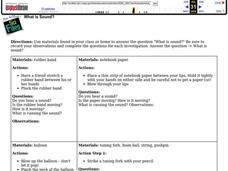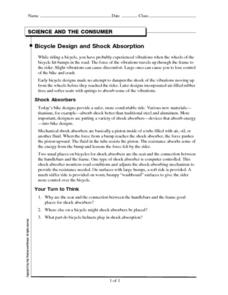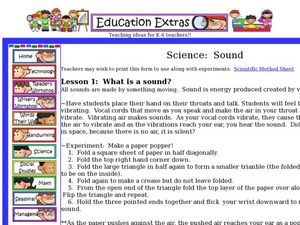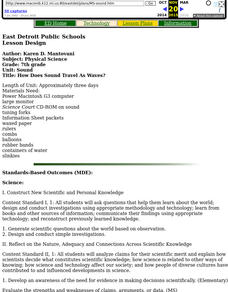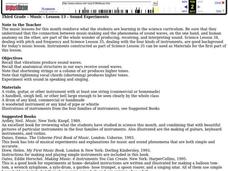Curated OER
Bronx Cheer Bulb
If you chew or make a "raspberry" while viewing an LED light source, the light will appear to wiggle or flicker. It is not because of the light itself, but because of the vibration of your skull! Have your physics class give this a try...
Curated OER
What is Sound?
In this sound worksheet, learners complete 4 investigations to explore sound. These include the use of a rubber band, a blown up balloon, a piece of notebook paper and a tuning fork with a foam ball, string and pushpin. Students answer...
Curated OER
Living on a Fault
In this earthquake worksheet, students fill in 9 blanks with given terms related to earthquake fault zones, earthquakes and safety related to earthquakes. They also answer 4 questions about earthquake zones, building codes and highway...
Curated OER
Bicycle Design and Shock Absorption
In this shock absorption worksheet, student read about bicycle design and how it effects shock absorption. They answer three critical thinking questions about bicycle design which make a bike ride smooth.
Curated OER
Sound Vibrations - Senses
Students experience vibrations using several of their senses, and design a test that uses their sense of hearing to judge the effectiveness of different solids to transmit sound vibrations.
Curated OER
Sound Vibrations
Young scholars play their own straw kazoos and understand that vibrations are responsible for the sounds we hear. Additionally, they learn that sound vibrations can travel through different mediums. Students experience vibrations ...
Curated OER
What is a Sound?
Second graders explore the concept of sound. For this sound lesson, 2nd graders discover what sound, vibrations, and pitch are through several experiments. Students watch a Power Point presentation that allows them to complete a graphic...
Curated OER
Great Gongs
For this sound worksheet, students use materials such as string, cups, paper clips and more to observe the vibrations made. Students then record their results.
Curated OER
Vibrating Objects Produce Sound
Students use many different materials and resources in order to study and identify sounds that are loud or soft, high or low, pleasant or unpleasant.
Curated OER
Your Song
Students create instruments to demonstrate their understanding of how the science of vibrations is used to create sounds.
Curated OER
Vibrations
Students explore how vibrations create sound by strumming a rubber band. They feel the vibration of their own vocal chords. Then they explore the motion of sound waves and echoes. They rely on their own hearing to locate others in their...
Curated OER
How Does Sound Travel As Waves?
Seventh graders participate in a number of activities designed to increase their understanding of how sound is generated and how it travels.
Curated OER
Sound: The Vibration of Materials
Students recognize that sound is produced by the vibration of materials. They see that the sound produced is dependent on the type of material that is used. Given four types of material; air, string, wood, and metal, students perform an...
Curated OER
Make a Sound Viewer
Students see, and thus better understand, the vibrations that sound makes through this simple project.
Curated OER
Hearing or Sound?
In this hearing worksheet, students complete a graphic organizer by filling in the steps between matter vibrating and hearing the sound.
Curated OER
Producing Sounds
Third graders examine items that make sounds. When given craft sticks, 3rd graders practice making different sounds with them. Sticks are rubbed together or placed partially on a desk and plucked. Afterward, students discuss the types of...
Curated OER
Sound
Second graders study how sound is produced by vibrations and is transmitted through matter in all directions. They observe how sounds are produced and identify the ways in which sound travels.
Curated OER
Sounds You See, Hear, and Feel
Students explore and create sound wave vibrations using musical instruments and common objects. They compare/contrast and describe actions that cause sound wave vibrations that can be seen, heard, and felt.
Curated OER
Music
Third graders study sound waves and vibrations. They sing a silly round in three parts.
Pennsylvania State University
Applied Physics: Model Analysis of an Electric Guitar
Great site explores the physics behind an electrical guitar. Outlines process for conducting an experiment on sound vibrations and provides animated GIF movies showing the first five modes of vibration.
Pennsylvania State University
Applied Physics: Vibrational Modes of a Circular Membrane (Drums)
Site tracks the vibrations of a drum and provides an animated movie.
Science Buddies
Science Buddies: Guitar Fundamentals: Wavelength, Frequency, & Speed
This is a rockin' project for guitarists with an interest in the physics behind music. If you have ever wondered why the pitch of the note changes when you fret the string, this project will help you understand by applying basic...
Science Buddies
Science Buddies: How to Make a Guitar Sing
This is a great project for musicians interested in the physics of stringed instruments. If you have ever played an acoustic guitar, you may have noticed that picking a single string can make one or more of the other (unpicked) strings...
Science Buddies
Science Buddies: How to Make a Piano Sing
The renowned pianist Vladimir Horowitz once said, "The most important thing is to transform the piano from a percussive instrument into a singing instrument." In this lab, you will learn about sympathetic vibrations, a method used to...



